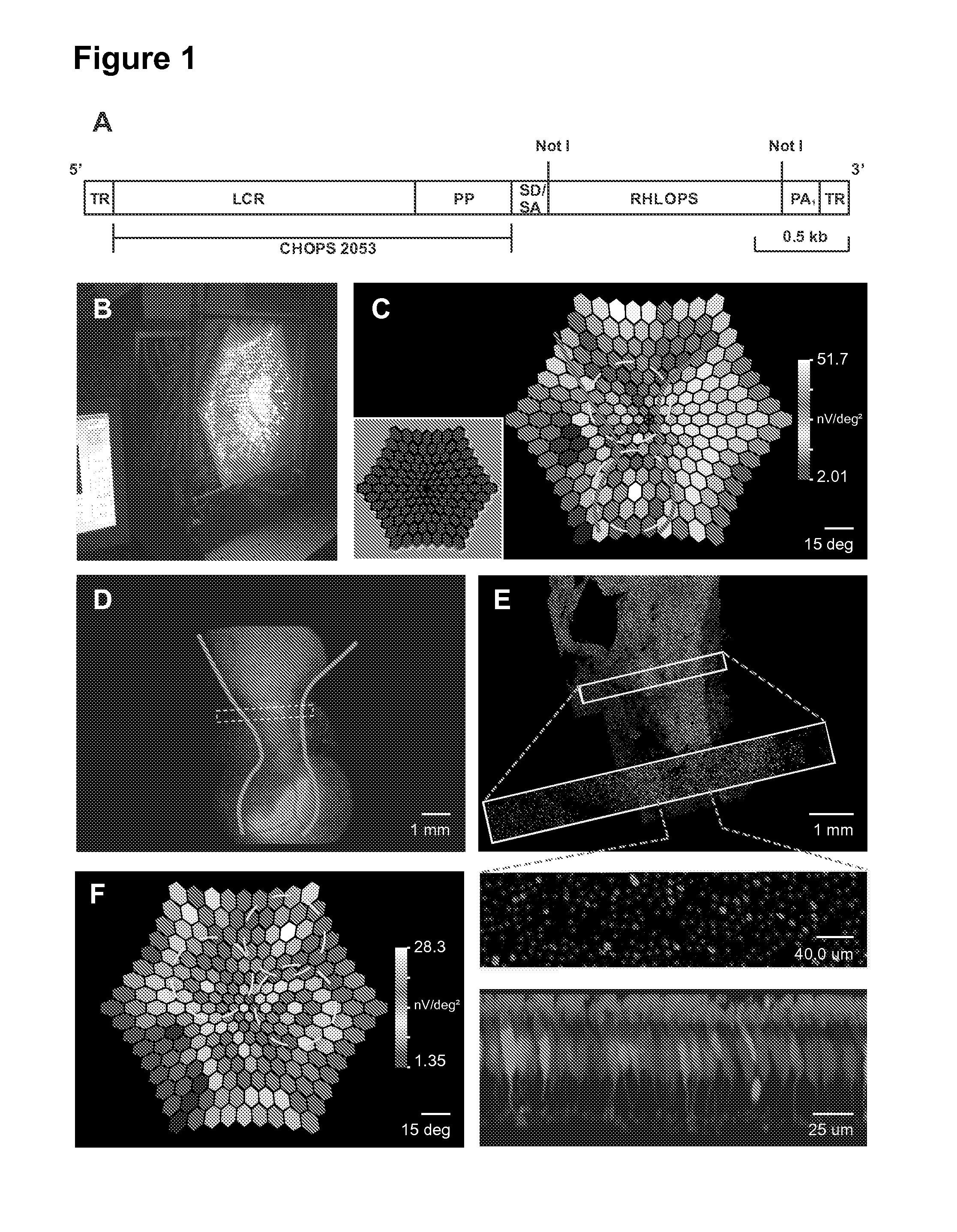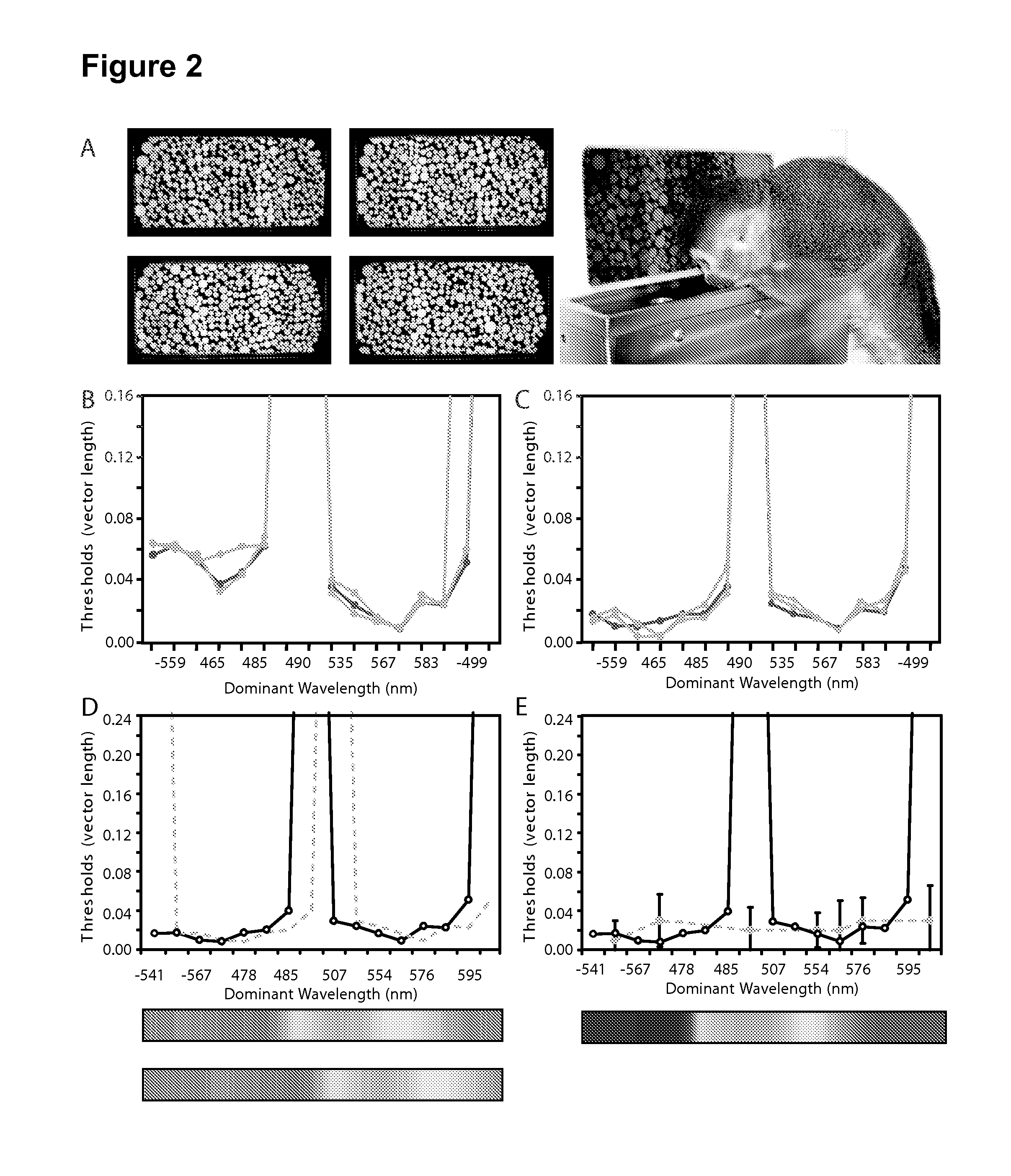Reagents and methods for modulating cone photoreceptor activity
a cone photoreceptor and activity technology, applied in the field of cone cell gene therapy, can solve the problems of ineffective treatment of congenital vision disorders, inability to appropriately process inputs that were not present at birth, and inability to properly process inputs established during development. to achieve the effect of restoring visual capacity
- Summary
- Abstract
- Description
- Claims
- Application Information
AI Technical Summary
Benefits of technology
Problems solved by technology
Method used
Image
Examples
example 1
REFERENCES FOR EXAMPLE 1
[0149]1. Wiesel, T. N. & Hubel, D. H. Single-cell responses in striate cortex of kittens deprived of vision in one eye. J. Neurophysiol. 26, 1003-1017 (1963).[0150]2. Jacobs, G. H. A perspective on color vision in platyrrhine monkeys. Vision Res. 38, 3307-3313 (1998).[0151]3. Li, Q., Timmers, A. M., Guy, J., Pang, J. & Hauswirth, W. W. Cone-specific expression using a human red opsin promoter in recombinant AAV. Vision Res. 48 (2007).[0152]4. Reffin, J. P., Astell, S. & Mollon. J. D. Trials of a computer-controlled colour vision test that preserves the advantages of pscudo-isochromatic plates, in Colour Vision Deficiencies X 69-76 (Kluwer Academic Publishers, Dordrecht, 1991).[0153]5. Regan, B. C., Reffin, J. P. & Mollon, J. D. Luminance noise and the rapid determination of discrimination ellipses in colour deficiency. Vision Res. 34, 1279-1299 (1994).[0154]6. Mancuso, K., Neitz, M. & Neitz, J. An adaptation of the Cambridge Colour Test for use with animals. ...
example 2
REFERENCES FOR EXAMPLE 2
[0191]Sutter, E. E. (1991). The Fast m-Transform: A Fast Computation of Cross-Correlations with Binary m-Sequences. SIAM Journal on Computing, 20(4), 686-694.[0192]Swanson, W. H., Ueno, T., Smith, V. C., & Pokorny, J. (1987). Temporal modulation sensitivity and pulse-detection thresholds for chromatic and luminance perturbations. Journal of the Optical Society of America A—Optics, Image Science and Vision. 4(10), 13.[0193]Lindenberg, T., Horn, F. K., & Korth. M. (2003). Cyclic summation versus m-sequence technique in the multifocal ERG. Graefes Archive of Clinical Experimental Ophthalmology., 241(6), 505-510.
PUM
| Property | Measurement | Unit |
|---|---|---|
| frequency | aaaaa | aaaaa |
| frequency | aaaaa | aaaaa |
| near dominant wavelength | aaaaa | aaaaa |
Abstract
Description
Claims
Application Information
 Login to View More
Login to View More - R&D
- Intellectual Property
- Life Sciences
- Materials
- Tech Scout
- Unparalleled Data Quality
- Higher Quality Content
- 60% Fewer Hallucinations
Browse by: Latest US Patents, China's latest patents, Technical Efficacy Thesaurus, Application Domain, Technology Topic, Popular Technical Reports.
© 2025 PatSnap. All rights reserved.Legal|Privacy policy|Modern Slavery Act Transparency Statement|Sitemap|About US| Contact US: help@patsnap.com



